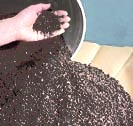Rock Binder's
Extender and Replacement of Asphalt Binders
Home
Independent
Laboratory
Procedure
MSDS
About Us
History
Contact
 |
|
 |
Paving pellets are now a reality. Bulk truck, rail, or containers of this high performance asphalt binder are avaliable for delivery. A comparable PG grade would be 82-22. |
- Trinidad Lake Asphalt has tremendous strength and performance properties, but it has never developed to full potential because of availability, price and handling handicaps.
- Sulfur Extended Asphalt (SEA) was reborn in the 1970's as a way to reduce the cost of asphalt binder by extending neat binder during the "energy" crisis. It never reached a high level of use, even though it offered performance enhancement in the form of higher stabilities, it could only offer lower cost until the increases of raw materials exceeded the cost of neat binder in the 1980's.
- Polymer Modified Asphalts have demonstrated many enhanced performance properties and are a primary method of achieving enhanced binder performance today, but their potential has been limited, primarily due to cost and issues in manufacturing and handling of the product.
Traditional Asphalts are the primary paving binder used around the world today, but they vary widely in quality, price and performance. Engineers have tried for years to identify and improve the appropriate performance qualities of binders with limited success.
Rock Binders has developed a binder that incorporates:
- Ease of handling and transportation issues.
- Toughness, strength, rut resistance, improved high temperature properties, and layer equivalency advantages of 10% to 15%.
- Cost advantages. Including as an extender or total substitute for asphalt cement.
- The cold temperature properties and improved workability gained from the use of a high quality neat asphalt binder as a base.
- Storage stability in a solid form with no storage emissions.
SEA Modifier Pellets are manufactured and delivered to the hot plant in pellet form. A typical hot mix application would introduce and incorporate the binder pellets through the drum RAP collar on a newer plant or into the pug mill on a batch plant. Generally a 1.5 SEA to 1 part AC oil substitution is used from 30% up to 50%. In other words about half the asphalt can be extended to do twice the "binding" work! Stronger and less expensive is a good combination.
ARP Paving Pellets are also in pellet form and used for eliminating the need for hot asphalt, including the storage and heating problems. It also eliminates the emission issue associated with hot asphalt storage. It provides for safer transportation of the binder because of its solid nature, eliminating the risk of hot asphalt spills. It has unlimited shelf life because of its solid nature and lack of a need for storage heating. It is a perfect choice for remote sites or economically prohibitive areas where it is difficult and costly to transport liquid asphalt. It can be shipped conventionally by rail, truck, ship or air anywhere in the world.
The use of SEA and ARP reduce the need for stability testing during the mix design process, because this binder produces a mix with stabilities higher than can be measured with today's conventional testing equipment! Also, because of the ongoing compatibility of the components, the stabilities continue to increase over time without losing hot or cold temperature properties. Since stability is not a design characteristic that can be conveniently measured, the mix is typically designed for voids and workability, using a conventional Marshall, Vheem, or Superpave design as a starting point.
Mixes utilizing SEA type formulations have been successfully used by Canada, United States,by the F.H.W.A., several State DOT’s, and the US Department of Interior with positive results over twenty years. (Western Research Institute, Phase II - Final Report of August 1997 FHWA Contract DTFH61-92-C-00170 & FHWA-RD-90-110).
